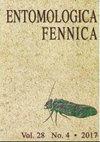Molecular identification of Trichogramma species from South and South-East Asia and natural Wolbachia infection
Q3 Agricultural and Biological Sciences
引用次数: 5
Abstract
Trichogramma wasps were collected from the parasitized eggs of lepidopteran pests from 21 sampling sites in East Asia and South-East Asia. Six Trichogramma species were identified based on the molecular identificationmethod using the internal transcribed spacer 2 (ITS2) region of the rDNAof Trichogramma chilonis, T. evanescens, T. ostriniae, T. embryophagum, T. dendrolimi and T. japonicum. The results of molecular identification were confirmed by morphological identification. Additionally, natural populations were screened for the prevalence of Wolbachia. Five out of 21 populations were infected by the same Wolbachia strain, which was identified by using Wolbachia wsp gene and multilocus sequencing approach. The phylogenetic analysis of Wolbachia wsp sequences revealed that the Wolbachia strain was classified in the strain wEvaA in the group of EvA of the supergroup A.南亚和东南亚赤眼蜂种类与自然沃尔巴克氏体感染的分子鉴定
从东亚和东南亚21个采样点的鳞翅目害虫寄生卵中采集了赤眼蜂。利用赤眼蜂(Trichogramma chilonis)、伊氏赤眼蜂、鸵鸟赤眼蜂和日本赤眼蜂rDNA的内部转录间隔区2(ITS2)区域进行分子鉴定,鉴定出6种赤眼蜂。形态学鉴定证实了分子鉴定的结果。此外,还对自然种群进行了沃尔巴克氏体流行率筛查。21个种群中有5个被相同的沃尔巴克氏体菌株感染,该菌株通过使用沃尔巴克氏菌wsp基因和多点测序方法进行鉴定。Wolbachia wsp序列的系统发育分析表明,该菌株被分类在A超群EvA组的wEvaA菌株中。
本文章由计算机程序翻译,如有差异,请以英文原文为准。
求助全文
约1分钟内获得全文
求助全文
来源期刊

Entomologica Fennica
生物-昆虫学
CiteScore
1.20
自引率
0.00%
发文量
0
审稿时长
>12 weeks
期刊介绍:
Cessation.Information not localized
 求助内容:
求助内容: 应助结果提醒方式:
应助结果提醒方式:


